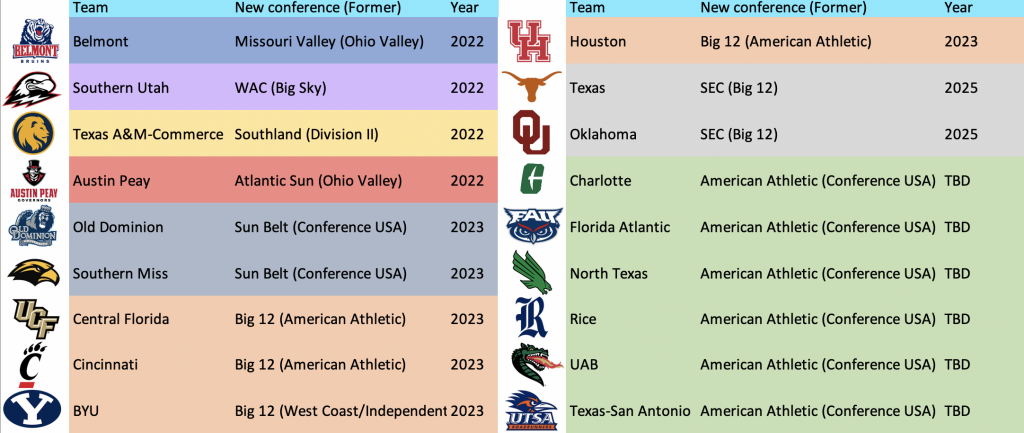I would assume that most of you remember the playground game “Red Rover” from your childhood days. Two teams stood in lines on opposite ends, locking hands, chanting “Red Rover, Red Rover, let (insert name) come over” and beckoning participants to run over to their side in hopes of growing their team.
Something similar is happening in the NCAA right now, as conferences like the SEC and the Sun Belt are planning to alter the landscape of their respective conferences and those from whom they poached from.
Conference realignment is no stranger to college sports. Schools typically come and go every few years, some more notable than others. But recently, the amount of institutions switching their allegiances has traditionalists lamenting and yearning for the days where the Big 12 had 12 schools, the Conference-USA was a powerhouse and geographic location was the primary determining factor in aligning conferences.
The announcement that Texas and Oklahoma would leave the Big 12 and join the SEC in 2025 was a Richter Scale-inducing shift in the landscape of college sports. While the Big 12 has remained in the national spotlight despite the losses of Colorado and Nebraska in 2011 and Missouri and Texas A&M in 2012 (the latter pair also heading to the SEC), the Longhorns and Sooners were arguably the biggest names left in the 25-year-old conference.
The pastures of the SEC, meanwhile, got a little greener, receiving two established programs in both football and basketball. The move will benefit the conference and both institutions financially, nearly doubling Oklahoma’s and Texas’ income from the Big 12, given the pure football dominance of the SEC. It’s no question that the zealous fan bases on both sides of the Red River will tune into their team’s matchups on ESPN, which just invested $3 billion to acquire broadcast rights for SEC football.
Before Big 12 fanatics get too worried about their conference’s future, BYU, Houston, Central Florida and Cincinnati are waiting in the wings to be added in 2025. In football, Cincinnati has finally awoken as a sleeping giant, currently ranked No. 2 in the AP poll and the other three teams consistently flirt with Top-25 status each year while playing in conferences with less competitive clout in nearly every sport.
Houston, UCF and Cincinnati all left the American Athletic Conference, which has proven to be more of a purgatory than a highly-respected conference since its inception in 2013. The AAC is perhaps at the center of conference realignment talk right now, as many of their members have plans to leave or are rumored to exit shortly.
Rather than list all the upcoming changes in conferences, the graphic below summarizes the dizzying amount of institutions moving around in the college sports landscape. The graphic doesn’t even account for 10 schools that recently switched conferences before the 2021-22 season.
What’s to make of these changes?
Most importantly, Bradley’s very own Missouri Valley Conference will be adding Belmont into the fray, a team that will significantly strengthen the conference in its hallmark of basketball. While nothing else is official, basketball powerhouse Murray State has been rumored to join the MVC as well.
Belmont signed off on joining the MVC for the typical reasons: geographic proximity and conference status/financials. The Missouri Valley consistently performs a notch better than the Ohio Valley, at least in basketball, leading to more exposure for the Bruins. This is especially true after the MVC sent two teams to the NCAA Tournament last year. Nashville’s location also makes it a manageable road trip for most schools in the conference.
Some schools on the list, such as Southern Miss and Southern Utah, left for conferences of similar status that overlapped geographically. Others, especially the light green contingent of the graphic, plan to exit en masse because of a domino effect. For every team that leaves, their conference gets slightly weaker and no team wants to be left behind.
What about the other schools, though?
It’s not fair to say that money doesn’t play a factor in conference realignment; why else would Maryland be in the Big 10? But for the Texases and Oklahomas of the world, the financial gain is even bigger. For colleges in states where it is legal for athletes to profit off their name, image and likeness, moving to the SEC gives recruits the potential to earn an even more lucrative paycheck. Case in point: Alabama freshman quarterback Bryce Young earned $1 million from NIL deals before even playing a snap in college.
After schools took a month off from competition due to COVID-19 and subsequently didn’t fill their stadiums with fans, every athletic department in the country is going to do whatever they can to recover from their losses. Sometimes moving conferences is the move that makes the most sense.
In many cases, conference realignment is helpful for the competitive balance of the schools’ teams. Realignment also brings new joys for fans of current conference members and for those of the school(s) gaining new competition. In Belmont’s case, anyone who avidly followed MVC basketball clamored for the perennial NCAA Tournament threat to consider joining from the OVC. Similarly, Belmont got a new lease on life after OVC rivals Austin Peay bought their departure ticket and Murray State has been rumored to leave as well.
Justifying the madness
Is conference realignment a great thing in every case? Not really, as some moves from the past decade still have some scratching their heads (looking at you, Rutgers). The downsides to reshuffling are long road trips, potentially leaving rivals behind and, perhaps most relevant now, criticisms for trying to make a “superconference.” After mass exoduses from schools, new conferences such as the controversial American Athletic Conference have been created and some have dissolved entirely. Pour one out for WAC football.
The argument against “superconferences,” such as the new-look SEC, are relevant, as some fans will miss the days where talented teams were more spread out and the gap between opposing forces of tradition and money was closer.
However, I don’t anticipate this to be a huge issue. After all, the old 16-team Big East sent 11 teams to March Madness in 2011 and Texas/Oklahoma joining the SEC gives opportunities for even more marquee football matchups to satisfy the appetite of college football fans.
Road trips will always be a part of any college sport, but recent and upcoming reshuffling has succeeded in keeping teams in a similar geographic area. And as schools change conferences, new rivalries can be formed and old rivalries such as Texas-Texas A&M are renewed.
College sports are in a constant state of flux right now, with NIL deals, transfer portal moves and conference realignments galore. It’s time we embrace the latter more often than not, as it will be beneficial for many stakeholders, including the schools, the media, the fans and the athletes.
It’s now time to say, “Red Rover, Red Rover, let the reshuffling take over.”






